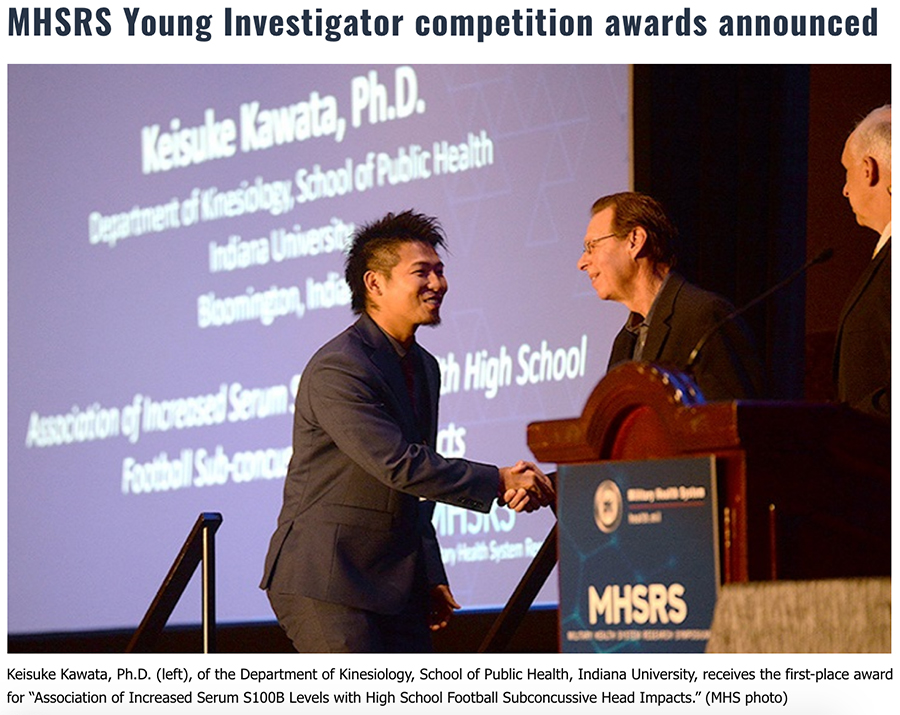Keisuke Kawata

Associate Professor
Email: kkawata@iu.edu
Phone: 812-855-5244
Address: 1025 E. 7th St.
Department: Kinesiology
B.S. Henderson State University 2010
M.S. Temple University 2013
Ph.D. Temple University 2016
- 2025 IU SPH Outstanding Senior Researcher Award
- 2021: Indiana University Outstanding Junior Faculty Award
- 2020: IU SPH Outstanding Early Career Scholar Award
- 2018: 1st Place Winner, Young Investigator Competition, Military Health System Research Symposium
- 2013-2016: Outstanding Graduate Research Award, Temple University
- 2011: Professional Internship, MLB Atlanta Braves
- 2010: Professional Internship, NFL Detroit Lions
- 2009: Professional Internship, MLS Sporting Kansas City

Extramural Grants
- 2024-2029 NIH-NINDS R01NS137276 (MPI: Kawata, Mickleborough, & Newman: 5 year $2,989,995 ): "A mechanistic clinical trial of omega-3 fatty acids to prevent subconcussive neural injury"
- 2024-2028 DoD-USAMRAA (PI: Bazarian, Co-Leads: Leddy, Kawata, Mannix: 4 year $6,294,939): "Monitoring and mitigation of neurological injuries to optimize resilience after repetitive head impacts (MONITOR RHI)"
- 2020-2025 NIH-NINDS R01NS113950-01A1 (PI: Kawata, 5 year $2,856,478 ): "Subconcussive neurodegenerative progression in adolescent athletes"
- 2020-2022 NIH-NINDS R21NS116548-01A1 (MPI: Kawata & Newman, 2 year $435,875): "Neuroimaging and blood biomarkers for subconcussive neural stress on ADHD"
- 2021-2023 Indiana State Department of Health (MPI: Kawata & Shin 2 year $200,000): "The role of gut microbiome in development of persistent post-concussive symptoms and subconcussive neurodegeneration in adolescents"
- 2017-2018 Indiana State Department of Health (PI: Kawata, 2 year $152,723 ): "Biochemical and behavioral markers for acute subconcussive head impacts"
Scholarly Interest
Research Area of Interest: Ever since my own traumatic brain injury experience, I have been pursuing to discover an effective diagnosis and rehabilitation protocol for patients with brain injury. While the vast majority of research has focused on a single impact that elicits concussion (e.g., disorientation, headache), many soldiers and athletes are frequently exposed to subconcussive head impacts prior to the concussive blow. Thus, it remains completely unknown whether neuronal damage and sensory deficit are caused by a single concussive blow, repetitive subconcussive impacts before the concussive blow, or both. To identify safe ranges of repetitive hits, my laboratory employs head accelerometer, blood biomarkers, ocular-motor system, and neuronal activity (using electroencephalography). By tracking subconcussive impacts combined with various parameters, we have witnessed a glimps of hope that some modalities could predict a concussion before it occurs. It is of my priority to establish brain-injury specific objective markers that to ensure soldiers and athletes’ safety while sustaining highest level of performance.

Kawata K, Liu CY, Merkel S, Ramirez S, Tierney R, & Langford D (2016). Blood Biomarkers for Brain Injury: What are we measuring? Neuroscience & Biobehavioral Reviews. 68: 460-473.
Kawata K, Rubin HL, Lee JH, Sim T, Takahagi M, Szwanki V, Bellamy A, Assari S, Darvish K, Henderer J, Tierney R, & Langford D (2016). Effect of football subconcussive head impact kinematics on ocular near point of convergence. JAMA Ophthalmology 134(7):763-769.
Zonner SW, Ejima K, Fulgar C, Charleston C, Huibregtse ME, Bevilacqua ZW, & Kawata K (2018). Oculomotor response to cumulative subconcussive head impacts in US high school football players: a pilot longitudinal study. JAMA Ophthalmology 137(3) 265-270.
Nowak MK, Bevilacqua ZW, Ejima K, Huibregtse ME, Chen Z, Mickleborough TD, Newman SD, & Kawata K (2020). Neuro-ophthalmologic response to repetitive subconcussive head impacts: a randomized clinical trial. JAMA Ophthalmology 138(4):350-357.
Cheever K, McDevitt J, Phillips J, & Kawata K (2021). The role of cervical symptoms in post-concussion management: A systematic review. Sports Medicine 51(9):1875-1891
Huibregtse ME, Bazarian JJ, Shultz SR, & Kawata K (2021). Biological significance and clinical utility of emerging blood biomarkers for brain injury. Neuroscience & Biobehavioral Reviews 130: 433–447
Zuidema TR, Huibregtse ME, & Kawata K (2022). Blood biomarkers may have found a new frontier in spaceflight. JAMA Neurology 79(6):632
Kercher KA, Steinfeldt JA, Macy JT, Seo DC, & Kawata K (2022). Drill intensity and head impact exposure in adolescent football. Pediatrics 150(5):e2022057725
Kercher KA, Steinfeldt JA, Rettke DR, Zuidema TR, Walker M, Kercher VM, Silveyra P, Seo DC,Macy JT, Hulvershorn LA, & Kawata K (2023). Association between head impact exposure, psychological need satisfaction, and indicators of mental health among U.S. high school tackle football players. Journal of Adolescent Health 72(4):502-509.
Kalbfell RM, Rettke DJ, Mackie K, Ejima K, Harezlak J, Alexander IL, Wager-Miller J, Johnson BD, Newman SD, & Kawata K (2023). The modulatory role of cannabis use in subconcussive neural injury. iScience 26(6):106948.
Zuidema TR, Bazarian JJ, Kercher KA, Rettke DJ, Mannix R, Kraft R, Newman SD, Ejima K, Macy JT, Steinfeldt JA, & Kawata K (2023). Longitudinal association of clinical and biochemical biomarkers with head impact exposure in adolescent football. JAMA Network Open 6(6):e2316601
Zuidema TR, Hou J, Kercher KA, Recht GO, Sweeney SH, Chenchaiah N, Cheng H, Steinfeldt JA, & Kawata K (2024). Cerebral cortical surface structure and neural activation pattern among adolescent football players. JAMA Network Open 7(2):e2354235

